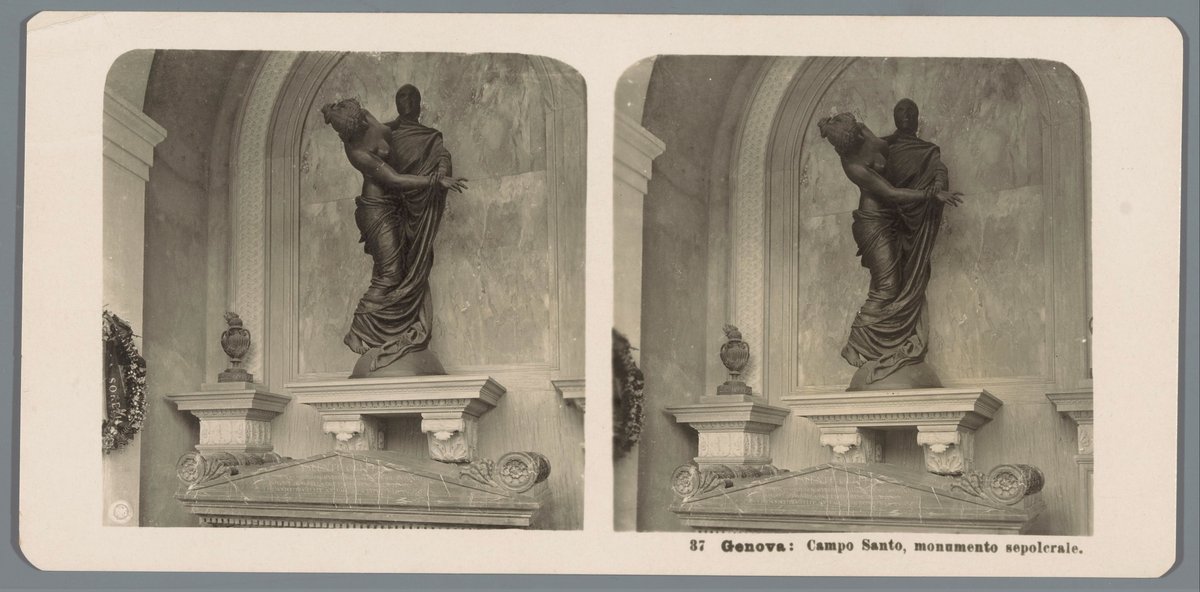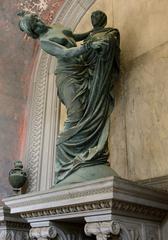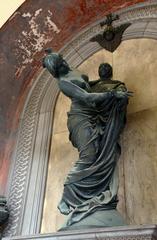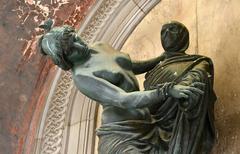
Tomba Celle Genoa Visiting Hours, Tickets, and Historical Sites Guide
Date: 14/06/2025
Introduction
Tomba Celle, one of Genoa’s most evocative and artistically significant monuments, stands within the Monumental Cemetery of Staglieno—an open-air museum renowned for its exceptional funerary art. Commissioned by the Celle family in the late 19th century and sculpted by Giulio Monteverde, the tomb captures the era’s preoccupation with mortality, memory, and the interplay between life and death. The bronze monument, widely known as “Il Dramma Eterno,” depicts a powerful tableau: a young woman, symbolizing Life, entwined with the skeletal figure of Death. This masterpiece reflects the cultural identity of Genoa and the broader Italian artistic tradition (Staglieno Cemetery official site, Symbols Project).
Visiting Tomba Celle offers far more than a viewing of funerary sculpture—it provides insight into Genoa’s social history, artistic evolution, and the symbolic language of mourning in an age of rapid transformation. This comprehensive guide covers the historical context, artistic features, visiting hours, ticketing, accessibility, travel tips, and recommendations for making the most of your experience at this iconic historical site.
Table of Contents
- Introduction
- Historical Background of Tomba Celle
- Giulio Monteverde and the Artistic Genesis
- Symbolism and Cultural Significance
- Artistic Techniques and Materials
- Visiting Tomba Celle: Hours, Tickets, Accessibility
- Guided Tours and Photography Tips
- Travel Tips: Getting There & Best Times to Visit
- Notable Nearby Monuments
- Frequently Asked Questions (FAQ)
- Conclusion
- References
Historical Background of Tomba Celle
Commissioned by Valente Celle, a wealthy Genoese merchant, Tomba Celle was conceived in the late 19th century, a time of significant economic, artistic, and social change in Genoa. The Monumental Cemetery of Staglieno, inaugurated in 1851, quickly became the resting place of the city’s elite, who sought to immortalize their legacies through grand memorials blending neoclassical and Symbolist styles (Lonely Planet).
During this period, Genoa experienced urban expansion and a flourishing of the arts. The Tomba Celle was created as a response to contemporary anxieties surrounding mortality and the afterlife, embodying the era’s fascination with the interplay between sensuality and death (Symbols Project).
Giulio Monteverde and the Artistic Genesis
Giulio Monteverde (1837–1917), renowned for his technical virtuosity and emotional realism, sculpted the Tomba Celle in bronze. The monument depicts a striking scene: a beautiful young woman (Life) ensnared by Death, rendered as a skeletal figure. This “danza macabra” (macabre dance) exemplifies the Symbolist movement’s focus on existence’s dualities (Symbols Project).
Monteverde’s original plaster model, kept at the Gipsoteca Giulio Monteverde in Bistagno, featured a fully nude female figure. At the Celle family’s request, the final bronze version added drapery, highlighting the tension between vulnerability and modesty while maintaining the monument’s emotional intensity.
Symbolism and Cultural Significance
Tomba Celle is celebrated not only for its technical brilliance but also for its profound symbolism. The juxtaposition of youthful beauty and skeletal decay highlights the transience of life and the universality of death. The narrative resonates with the fin de siècle’s existential anxieties and Genoa’s shifting social landscape (Lonely Planet).
The monument underscores the role of Staglieno Cemetery as an open-air museum, where memory, art, and urban identity intersect. Its influence extended well beyond Genoa, shaping funerary art across Europe (Staglieno Cemetery official site).
Artistic Techniques and Materials
Monteverde chose bronze for the Tomba Celle, allowing for expressive, durable sculpture. The lifelike details—flowing hair, delicate features, and dynamic drapery—contrast with the angular, skeletal Death. The monument’s placement in the grand arcades among lush vegetation amplifies its visual and emotional impact (Symbols Project).
Visiting Tomba Celle: Hours, Tickets, Accessibility
Visiting Hours
The Monumental Cemetery of Staglieno is typically open daily from 8:00 AM to 6:00 PM, with extended hours in summer. Always check the official cemetery website for seasonal changes or special closures.
Tickets & Entry
Entry to Staglieno Cemetery and Tomba Celle is free. Some guided tours or special exhibitions may require a ticket; advance booking is recommended during peak periods.
Accessibility
The cemetery covers a vast area with uneven terrain and some steep sectors. While main pathways are accessible, visitors with mobility challenges should consult staff for the most suitable routes. Wheelchair access may be limited in certain areas.
Guided Tours and Photography Tips
Guided tours, available through local operators and the cemetery office, are highly recommended to appreciate the historical and artistic context. Thematic tours focus on funerary art, symbolism, or Genoese history. Photography is permitted for personal, non-commercial use; use of flash or professional equipment requires prior permission. Please observe respectful conduct at all times.
Travel Tips: Getting There & Best Times to Visit
- Location: Staglieno Cemetery is about 4 km southeast of Genoa’s city center.
- Public Transport: Bus lines 31, 36, and 37 connect the city center to the cemetery entrance. Taxis and rideshares are also available.
- Parking: Limited parking is available; public transport is recommended.
- Best Times: Early mornings and weekdays offer a quieter, more contemplative visit. Spring and autumn provide pleasant weather.
Notable Nearby Monuments
While visiting Tomba Celle, explore other masterpieces in the Porticato Superiore, such as the tombs of Da Passano, Erba, and Gallino, and works by Santo Varni and Augusto Rivalta. Staglieno is renowned for its concentration of monumental art and offers thematic itineraries for deeper exploration (Atlas Obscura: Staglieno Cemetery).
Nearby, Genoa’s historic center, Palazzo Ducale, Via Garibaldi, and the Porto Antico are all easily accessible and offer rich cultural experiences (Trip101).
Frequently Asked Questions (FAQ)
Q: What are the visiting hours for Tomba Celle?
A: Generally, the cemetery is open from 8:00 AM to 6:00 PM, with seasonal variations.
Q: Is there an entrance fee?
A: No, entry is free. Some guided tours may require a fee.
Q: Are guided tours available in English?
A: Yes, but advance booking is recommended.
Q: Is the site accessible for visitors with disabilities?
A: The main pathways are accessible, but some areas have uneven ground or steps; consult staff for accessible routes.
Q: Can I take photos at Tomba Celle?
A: Yes, for personal use. Professional photography requires prior permission.
Q: How do I get to Staglieno Cemetery from the city center?
A: Use bus lines 31, 36, or 37, or take a taxi.
Conclusion
Tomba Celle stands as a profound testament to Genoa’s artistic legacy, blending technical mastery and deep symbolism to address universal themes of life, death, and remembrance. As a centerpiece of the Monumental Cemetery of Staglieno, it offers visitors a rich encounter with history, art, and Genoese culture.
For a meaningful visit, take advantage of guided tours, virtual resources, and interactive maps. The Audiala app provides curated audio guides and up-to-date travel tips. Explore nearby attractions to experience the full breadth of Genoa’s historical and artistic treasures.
References
- Staglieno Cemetery official site
- Symbols Project: Tomba Celle
- Lonely Planet Guide to Genoa
- Atlas Obscura: Staglieno Cemetery
- Rough Guides: Genoa
- Next Level of Travel: Genoa
- Hikersbay: Tomba Vicini and Genoa History
- Trip101: Best Things to Do in Genoa
- Checkinblog: Places to Visit Near Genoa





































































































